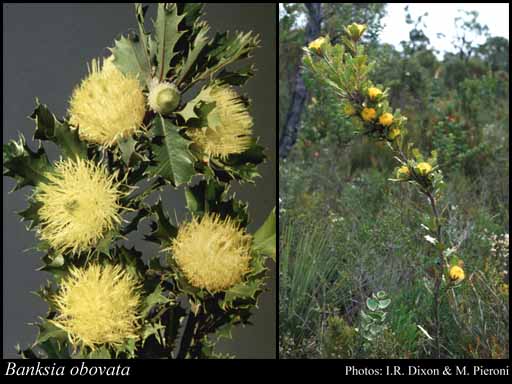- Reference
- Austral.Syst.Bot. 20:65 (2007)
- Conservation Code
- Not threatened
- Naturalised Status
- Native to Western Australia
- Name Status
- Current
Prickly, dense, non-lignotuberous shrub, 0.4-2 m high. Fl. cream-yellow/yellow-orange, Apr to May or Aug to Nov or Jan. White/grey sand, often over laterite or granite, clay loam.

Scientific Description
Shrubs, 1-2 m high; branchlets hairy. Leaves petiolate, alternate, 30-75 mm long, 10-30 mm wide, hairy; petiole 5-12 mm long; lamina flat, clearly widest above the middle, once divided, pinnately divided, shallowly divided, teeth distinctly pointing towards the apex, with 7-12 lobes on each side, the margins flat. Inflorescences hirsute (with long, rough and coarse hairs), yellow; innermost bracts 10-15 mm long, hairy. Perianth 23-38 mm long, hairy, all over, limb apex hirsute (with long, rough and coarse hairs), without awns; pistil 26-42 mm long, straight or curved, style glabrous. Follicles hairy, pubescent (with soft, straight, erect hairs), obovate, 10-14 mm long. Flowers in April, May, June, July, August, September, October or November. Occurs in the South-west (SW) Botanical Province(s), in the Avon Wheatbelt (AW), Jarrah Forest (JF), Mallee (MAL) or Esperance Plains (ESP) IBRA subregion(s).
Distribution
- IBRA Regions
- Avon Wheatbelt, Esperance Plains, Jarrah Forest, Mallee.
- IBRA Subregions
- Eastern Mallee, Fitzgerald, Katanning, Merredin, Northern Jarrah Forest, Recherche, Southern Jarrah Forest, Western Mallee.
- IMCRA Regions
- WA South Coast.
- Local Government Areas (LGAs)
- Albany, Broomehill-Tambellup, Corrigin, Cranbrook, Dumbleyung, Esperance, Gnowangerup, Jerramungup, Kent, Kulin, Lake Grace, Plantagenet, Ravensthorpe, West Arthur, Wickepin, Woodanilling.